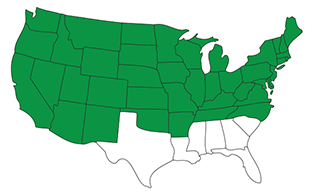
Clover Mite
Bryobia praetiosa
The Clover Mite is a tiny lawn-damaging pest that's actually a relative of two arachnids: the Spider and the Tick. Also known as Bryobia praetiosa, this lawn pest often invades homes and other indoor environments during the spring and fall months. The Clover Mite is found throughout much of North America and commonly affects Kentucky Bluegrass and Perennial Ryegrass.
Identify

Leaf & Stem
The adult Clover Mite is dark brown to greenish-brown and has front legs about twice the length of its other legs. All of this lawn pest's legs are reddish-orange and its body is oval-shaped and slightly depressed with scattered, flattened hairs on the back. Immature mites are dull red and can be easily seen with a 10X magnifying glass. The Clover Mite probes at the surface of grass blades and sucks out the juices, resulting in a loss of chlorophyll and moisture that causes your lawn to have a silvery appearance. Areas that are heavily infested with this lawn-damaging insect sometimes fail to green-up in the spring. Clover Mite damage is most often concentrated in areas close to the south and west sides of buildings where lush grass growth is found. When this lawn pest is crushed, it leaves orange-red stains that are difficult to remove.
Life Cycle
The Clover Mite is an unusual lawn pest because it is most active during the cooler spring and fall seasons rather than the warmer seasons. Its eggs can remain dormant over the summer and winter—several overlapping generations occur each fall and spring. Throughout winter, Clover Mites can be found hanging out where the grass doesn't freeze.

Control
There are two methods for controlling Clover Mites that TruGreen® recommends: 1. Use professionally applied pest control designed to prevent excess lawn pest populations, which can cause damage to your lawn 2. Kill insects, grubs and other lawn pests before they have a chance to damage your lawn Proper mowing and watering techniques can also help foster a healthy lawn that's more tolerant to lawn pest attacks—plus you'll get a lawn you'll want to live on in the process.




Facebook
X
Youtube
Copy Link
Email